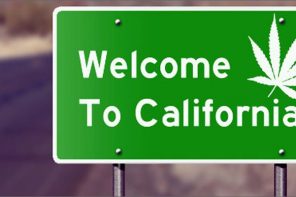Big news for California activists and voters this week, as the Coalition for Cannabis Policy Reform (ReformCA) announced via email and social media that they have officially filed the 2016 cannabis legalization initiative for the upcoming California general election.
The coalition was initially waiting for the AB 266 regulations to be signed into law by the Governor, so that they could try and model the adult use licensing and regulation structure after the proposed medical cannabis rules. But alas, Jerry Brown’s coveted signature on that bill is taking longer than first expected.
California is a unique set and setting in which the nation’s biggest cannabis battle is still being fought. Arguably, home of the finest quality cannabis in the world, the Golden State was the first state to allow medical marijuana in 1996, but voters have failed at implementing full decriminalization on two different attempts – once in 1972, and again, more shockingly, in 2010.
Many assumptions still float around as to why the 2010 initiative failed, from the vehement dissent of many Emerald Triangle growers to the initiative running in a low-turnout midterm election. Now that four states (Colorado, Washington, Oregon, Alaska) and Washington, D.C. have decriminalized cannabis for adult use, the legalization question has shifted from “should we?” to “HOW should we?” in a relatively short span of time.
Buffeted by the successful creation of cannabis industries in Colorado and Washington state, California activists now have the perfect chance to end prohibition once and for all and establish firm industry guidelines and standards, building on what’s working for the legal states while actively integrating feedback from individuals in every facet of the space.
The initiative seems to cover nearly every concern for the industry and population at large; its stated purpose is to:
- Eliminate civil and criminal penalties for adults 21 and over
- Continue to prohibit dangerous activities, like driving, under the influence of cannabis
- Establish a state office to regulate licensing and public health issues
- Prevent revenues from licensed cannabis commerce from reaching criminal enterprises or being diverted to other non-legalized states, prevent drug-related violence and DUI
- Prevent cannabis cultivation on California and federal public lands
- Raise tax revenue for schools, public health, drug abuse prevention, the environment, community restoration, and further drug policy strategy
- Improve law enforcement strategy for targeting violent crime rather than minimal cannabis-related “crimes”
- Ensure a licensed market for small- and mid-size entities and prevent corporate takeover
- Ensure that existing medical cannabis laws work parallel to and in conjunction with any recreational cannabis policies that are enacted
- Encourage development of legislation that is responsive to new scientific discoveries, legal developments and public health or safety issues
- Express the will of the People of the State of California that the federal scheduling of cannabis be changed under Title 21 of the US Code Controlled Substances Act, and to deschedule cannabis from the California Uniform Controlled Substances Act
Read the full text of the initiative here.
On the whole, the measure aims to treat cannabis somewhat like alcohol, minus allowing licenses for public consumption in a bar or restaurant setting. Purchase, possession, consumption and industry employment will only be for those aged 21 and up, with criminal penalties for supplying to minors. Personal possession and transport will be limited to one ounce of cannabis at a time, and home grows up to 100 square feet are permitted. To the seasoned member of the cannabis subculture, these are certainly restrictions, but on a grand scale it’s going to allow individuals to consume free of fear of prosecution, and there’s something to be said for that.
Perhaps the most interesting portion of the initiative contains the details on the Office of Cannabis Regulation, a new state agency that the measure will establish within the California Department of Consumer Affairs. The seven public members and six ex officio administrators, collectively the California Cannabis Commission, will consist of:
- Three public members appointed by the Governor, one each with emphasis in:
- public health/medical cannabis
- local government
- law enforcement
- Two public members appointed by the Senate Rules Committee, one each with emphasis in:
- environmental issues
- substantial experience providing cannabis to medical patients
- Two public members appointed by the Speaker of the Assembly, one each with emphasis in:
- the cannabis industry
- organized labor
- The Lieutenant Governor of California (or authorized representative)
- The California Attorney General (or authorized representative)
- A member of the California Board of Equalization (or authorized representative)
- The Secretary of the California Department of Food and Agriculture (or authorized representative)
- The Secretary of the Department of Consumer Affairs (or authorized representative)
- The Secretary of the Environmental Protection Agency (or authorized representative)
California Cannabis Commission members will serve 4-year terms, and public members will receive $100 per diem while on official business. There are plenty of valid concerns about bureaucracy overwhelming the industry, but on the other hand, someone has to do the dirty job of overseeing the laundry list regulations, and ReformCA’s initiative language seems to promote a fair and effective agency structure.
The Control, Regulate, and Tax Cannabis Act also stipulates the creation of a Cannabis Safety Fund. This is where the tax revenue collected from adult recreational cannabis sales will be put to use for education, harm reduction, public health and environmental research, and law enforcement needs. Around 50-60 percent of all revenue raised from cannabis will go to various stages of education, with a particular focus on preschool and early childhood education, and youth counseling, after-school programs and health care for K-12.
Of course, voters and cannabis movement insiders want to know one thing in particular: Just how much taxation are we talking about here? The measure lists tax policies as follows:
- Cultivation Tax
- The measure will impose an annual cultivation tax of $2 per square foot of canopy. Half goes to the city or county, and the other half goes to the Cannabis Safety Fund, specifically the Environmental Restoration & Protection Account.
- Production Tax
- Harvested and processed cannabis that enters the commercial market will be taxed at $15 per dried ounce of flower, but for small-scale cultivators, the tax on the first 500 pounds of the year is reduced to $5 per ounce.
- The first purchaser is responsible for paying the tax (wholesalers, manufacturers, etc, – not the consumer).
- Retail Tax on Sales
- Flower will be taxed at a rate of 5 percent, and edibles and concentrates will be taxed at 10 percent. This is only for recreational sales.
- All revenues from this tax go to the Cannabis Safety Fund.
- Retail Tax for Local Government
- Another 5 percent flat tax applies on all flower and products sold, but these funds are remitted to the city and/or county.
- Local governments cannot create any additional taxes on top of this, though they are permitted to regulate zoning and commerce policies within local jurisdictions.
Read the full text of the initiative here.
California is unique in that it houses 10% of the United States population, while simultaneously supplying most of the nation’s agriculture. It is by far the biggest and most crucial piece of the cannabis landscape, being the original medical cannabis state and the epicenter of American cannabis production and culture. What happens in California in November 2016 will inevitably change the cannabis movement forever, both nationally and globally.
However, there is a conflicting initiative with ballot language already approved, called the Marijuana Control, Legalization & Revenue Act. This could make things difficult for California voters in November when a unified, singular message will be absolutely essential to victory.
Cashinbis promises to continue keeping our audience informed about the California election and other legalization milestones from around the nation, remaining unbiased on the minutia, except that we believe in equal access and equal opportunity for patients, consumers, and businesspeople alike.
What do you think about the initiative language? Feel free to sound off and engage this election season – we want to hear what the community thinks!








